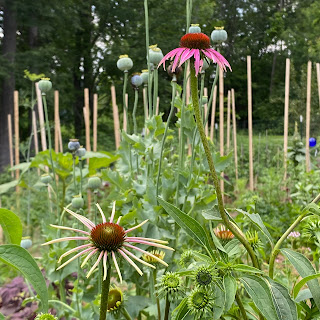
“The Marigold that goes to bed with the sun,
And with him rises weeping.”
- William Shakespeare, from Winter’s Tale.
Meet Calendula officinalis – Calendula, Pot Marigold, Marigold
The beautiful genus of Calendula represents some 20 'r so herbaceous perennial species (annual in our region) of lovely flowering plants in the Asteraceae family. It’s considered native to western Europe, southern Asia, Macaronesia, Egypt, Iran, and the Mediterranean, yet it’s been cultivated for so long around the globe that its exact origin is a lovely mystery. Yet given what we know about the origins of life on earth, I’m betting on Egypt, or Macaronesia, of those named above.
The genus, Calendula, is born of the Latin calendae, meaning the first, first day of the month, little calendar, or little clock.
Calendula officinalis is an easy-to-grow plant that will reach more than 2 feet in a favorable environment (if it doesn’t flop over first). It's described as having sparsely branched lax or erect stems, and indeed, offers both characteristics. The leaves grow from 3 to 7 inches and are oblong-lanceolate, hairy on both sides. And they're sticky too, the leaves and the flowers.
The daisy-like flowers are yellow to golden orange, some with variegated petals offering lovely variations of these warm colors. The flowers are surrounded by two rows of hairy bracts, with peripheral female ray florets surrounding the central disc florets which are tubular and hermaphrodite and a more intense golden color than the female ray florets. The flowers bloom all summer and into autumn and mild winters in our southern New England region and produces a fruit that is thorny and curved.
Calendula grows easily and generously in full sun in most any soil. While I do collect seed from the most robust plants, others go to seed where they're rooted, and - with appreciation - reseed and propagate themselves generously.
Family: Asteraceae
Harvest: Aerial parts – buds and blooms from summer to winter, seeds in autumn to winter, or whenever you allow the flowers to mature to seed. Leaves, anytime. And like so many flowering annuals, the more you trim the buds and flowers for harvest, the more buds and flowers the plant will offer.
Taste: bitter and pungent.
Humors & Energetic: Warm 'n' Dry. Gently stimulating.
Actions: Anti-inflammatory/inflammatory-modulating (esp: skin 'n' mucosa), antimicrobial, antispasmodic, aromatic, astringent, cholagogue, emmenagogue, demulcent, diaphoretic, hepatic, immune-modulating, lymphatic/lymphagogue, vulnerary.
Constituents: alkaloids, antioxidants, bitters, calendic acid, chlorogenic acid, flavonoids, glycosides, resin, sterols, triterpenes (calendulosides A-D), volatile oil and more.
Contraindications: Potential allergic reactions, like so many of the Asteraceae family.
Chakra Association: Solar Plexus (your mileage may vary).
Uses:
This plant has a long history of generosity as a Food, as internal and external Medicine, as dye (for food, hair, fiber), and as a ceremonial botanical. It’s challenging to gauge where to start…
I mean… Maude Grieve makes mention in The Modern Herbal of benefits to the heart, ulcers, eyesight and sore eyes, to varicose veins, jaundice, bee stings, sprains, and wounds, to clearing skin eruptions and head mucus, fevers, for use against the plague, for drawing out evil, as a dye, and, of course, as food.
I suppose starting with my most frequent use might be a place to root this section…
Most every day, with the rarest of exceptions, an infused oil of calendula flowers makes it to my skin. I keep it the oil near the showers (indoors 'n' out) to use after showering. It's around me in that liquid oil form, as a soft salve, and as a a more solid balm. As an infused oil it a standard in my First Aid bag. I use it on fresh scuffs 'n' cuts, and healing wounds of every kind, and it’s often a base oil in my foot-rub balms. It’s almost always a part of my base oil for lip balm, and it frequently finds its way into my handmade soaps.
I most often describe infused oil of calendula (as well as tincture and water infusion) as promoting healthy tissue growth (vulnerary), while promoting the prevention of infection as well as scarring. I credit Calendula for having no signs of a facial burn, as it was part of a three-tier treatment starting with fresh aloe, then St. Joan and then Calendula. Others have sung its praises over the years for preventing scars, often surprisingly so.
Rosalee de la Forêt sites a study demonstrating its topical use being protective to the skin from radiation damage.
Calendula finds its way into my facial 'n' respiratory steams, foot and body bath blends.
A dilute of the tincture is also one of my (many) herbal choices for a mouth rinse, to promote healthy gums.
As an internal, in tincture form, I’ve mostly used it as a gentle lymphatic, after illness, especially when all or some of the symptoms are sticky and don’t fully clear, or when swelling is sticky in the lymph nodes. Calendula comes to mind 'n' heart whenever sticky conditions present.
I’ve also used the tincture in blends or in tiered protocols for nourishing 'n' toning the immune system, especially after long convalescences or antibiotic use.
The tincture has a reputation for un-sticking a sticky menses. Henriette Kress credits Calendula with regulating menstruation and preventing crampy menses.
David Hoffman has done clinical work that conveys historical/experiential evidence of its value in treating gastric and duodenal ulcers, and other digestive inflammatory conditions. He notes that it relieves gallbladder challenges as well as those “vague digestive complaints known as ‘indigestion.’”
Matt Wood notes it as warming to a weak or atonic digestion, and I find it, in this light, to be something to enjoy as Food in its season and as tea throughout the cooler months, as it will offer its tonic/toning verve to our digestive system from teeth/gums to evacuation… for it adds sunshine to the darkest places.
And I do find drop doses of the tincture added to waters or teas in deep winter to calm my anxiousness, perk me up and lift my spirits. It’s another herb that I refer to as liquid sunshine. As a tea I find it to be quite calming and quieting without making me drowsy. In this moody light (or darkness, as the case may be), I might add that Matt Wood has referred to Calendula and “industrial strength chamomile,” which is memorable phrasing worthy of recall. ::nods::
But mostly, for me, it finds its way into many a tea blend, which, like Food, is – indeed – a daily ritual…
As a Food, I've seen it referenced as “poor man’s saffron,” the flower petals being used to color cheeses, soups, and more.
For years I’ve added the petals to batters to make “confetti” muffins, pancakes and cookies. I don’t remember where I first heard the term, but I love it.
In winter, I sometimes add the dried flower to soup stocks, and the petals to finished soups to rehydrate as a summery sunshine garnish.
The petals often find themselves added to summer salads of every kind. The flowers make a lovely garnish floating atop most any beverage, and I sometimes add them to my cold-water infusions along with mints, elder flowers, currant leaves and others.
Lastly, Lisa Estabrook relays Calendula this way, in her Soulflower Plant Spirit Oracle Deck:
“Calendula – Communication
Our thoughts and words have great creative power, both positive and negative, for ourselves and others. Calendula helps soothe your thoughts and words with warmth and compassion and understanding so that there is a balance between assertiveness and receptiveness in communication with others.”
Dance with the Calendula officinalis – Calendula.
I love adding fresh petals to all sorts of batters and the like: Pancakes, muffins, sweet breads, plain cookies, cornbread, hominy, polenta, and so on – use your imagination to add color 'n' other benefits to your homemade foods.
Blend the petals into soft cheeses.
Pluck the flower petals to add to salads or use as a garnish for many summertime dishes – be it vegetable, fruit, grain, or meat.
Need I mention Calendula Tea?
I know, it goes without saying… but this flower tea plays so nice with other herbs and makes a nice base or addition for many a tea blend, be it cool 'n' minty, or warm 'n' spicy.
The tea or long-brew infusion may be added to soups, stews and other simmers, so consider an infusion as a soup stock base or partial base.
Plus, Calendula infusion makes a wonderful wash, compress, or addition to baths and soaks.
The leaves of Calendula have a history as Food, cooked alone as a green, added to soups, yet it's not a favored flavor of mine. I prefer the petals, but your pallet may disagree.
If you imbibe, make a Calendula Infused Brandy!
Simply macerate some flowers in brandy for 4-8 weeks, strain and enJOY a sip of liquid sunshine. Sweeten it with honey for an elixir, or with cane sugar for a cordial. And, frankly, vodka is quite nice too, so make a big batch of vodka-based tincture and leave some as is, sweeten some with honey, and sweeten some with cane sugar, maple sugar to enJOY as a nice reward for efficient multi-tasking.
Elderberry Calendula Cold and Flu Elixir Recipe
source: theherbalacademy.com
1 cup fresh (or 2/3 cup dried) calendula flowers
2/3 cup dried elderberries
1/2 cup fresh (or 1/3 cup dried) elderflowers
1/2 cup fresh (or 1/3 cup dried) rose hips
2 tablespoons fresh (or 1 tablespoon dried) orange peel
1 tablespoons fresh (or 1 teaspoon dried) ginger
Brandy
Honey
- Fill a clean, sterilized quart jar (4 cup capacity) with herbs.
- Add brandy, pouring until herbs covered by 1-2 inches of brandy and jar is approximately 3/4 full.
- Add honey, leaving 1 inch of space at the top of the jar.
- Poke chopstick into jar to release any trapped air bubbles and ensure brandy and honey are coating herbs.
- Put cap on and label jar with ingredients and date.
- Let steep for 4-6 weeks in a cool, dark place, shaking daily.
- Filter elixir by pouring through a fine mesh filter or several layers of cheesecloth over a bowl or wide-mouth jar. Press the marc (plant material) to squeeze out every last drop of elixir.
- Compost the marc and cap and label the elixir.
What else might you be inspired to do with lovely Calendula?
Here’s my old Herb of the Month list of many of the ways you might honor and leverage the gifts of this generous botanical. Add to it, and share your experiences with others.
· tea
· tincture
· liniment
· salves/balms
· eyewash
· neti pot addition
· infused vinegar
· infused oil
· soap
· leaves and flowers in a green powder
· compress
· poultice
· eye wash
· baths, soaks, sitz baths
· sugar scrub
· salt scrub
· syrup
· jelly
· hard candy
· infused honey
· water color paint
· steams
· spiritual baths and healing ceremonies
resources:
- David Hoffman, Medical Herbalism
- Green Dean, Eat the Weeds
- Henriette Kress, Practical Herbs 1 & 2 & Henriette’s Herbal Homepage
- Matthew Wood, The Book of Herbal Wisdom & The Earthwise Herbal Repertory
- Maude Grieve, A Modern Herbal
- Rosalee de la Forêt, Herbs with Rosalee
- Wikipedia – for some of the botanical bits
- Personal notes from multiple sources
- Personal experience
This post represents and encompasses much of the material presented over decades of teaching.
Peace. 🕊










.JPG)



